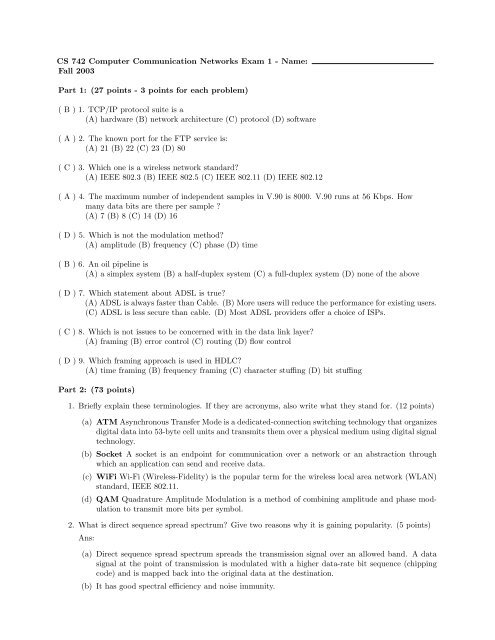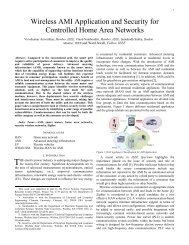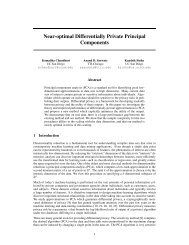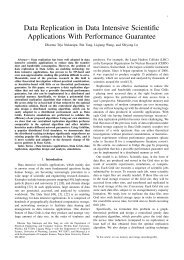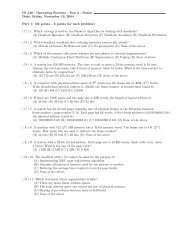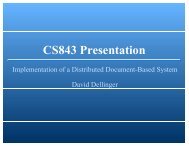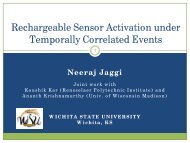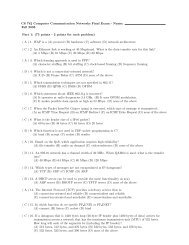CS 742 Computer Communication Networks Exam 1 - Name: Fall ...
CS 742 Computer Communication Networks Exam 1 - Name: Fall ...
CS 742 Computer Communication Networks Exam 1 - Name: Fall ...
Create successful ePaper yourself
Turn your PDF publications into a flip-book with our unique Google optimized e-Paper software.
<strong>CS</strong> <strong>742</strong> <strong>Computer</strong> <strong>Communication</strong> <strong>Networks</strong> <strong>Exam</strong> 1 - <strong>Name</strong>:<br />
<strong>Fall</strong> 2003<br />
Part 1: (27 points - 3 points for each problem)<br />
( B ) 1. TCP/IP protocol suite is a<br />
(A) hardware (B) network architecture (C) protocol (D) software<br />
( A ) 2. The known port for the FTP service is:<br />
(A) 21 (B) 22 (C) 23 (D) 80<br />
( C ) 3. Which one is a wireless network standard?<br />
(A) IEEE 802.3 (B) IEEE 802.5 (C) IEEE 802.11 (D) IEEE 802.12<br />
( A ) 4. The maximum number of independent samples in V.90 is 8000. V.90 runs at 56 Kbps. How<br />
many data bits are there per sample ?<br />
(A) 7 (B) 8 (C) 14 (D) 16<br />
( D ) 5. Which is not the modulation method?<br />
(A) amplitude (B) frequency (C) phase (D) time<br />
( B ) 6. An oil pipeline is<br />
(A) a simplex system (B) a half-duplex system (C) a full-duplex system (D) none of the above<br />
( D ) 7. Which statement about ADSL is true?<br />
(A) ADSL is always faster than Cable. (B) More users will reduce the performance for existing users.<br />
(C) ADSL is less secure than cable. (D) Most ADSL providers offer a choice of ISPs.<br />
( C ) 8. Which is not issues to be concerned with in the data link layer?<br />
(A) framing (B) error control (C) routing (D) flow control<br />
( D ) 9. Which framing approach is used in HDLC?<br />
(A) time framing (B) frequency framing (C) character stuffing (D) bit stuffing<br />
Part 2: (73 points)<br />
1. Briefly explain these terminologies. If they are acronyms, also write what they stand for. (12 points)<br />
(a) ATM Asynchronous Transfer Mode is a dedicated-connection switching technology that organizes<br />
digital data into 53-byte cell units and transmits them over a physical medium using digital signal<br />
technology.<br />
(b) Socket A socket is an endpoint for communication over a network or an abstraction through<br />
which an application can send and receive data.<br />
(c) WiFi Wi-Fi (Wireless-Fidelity) is the popular term for the wireless local area network (WLAN)<br />
standard, IEEE 802.11.<br />
(d) QAM Quadrature Amplitude Modulation is a method of combining amplitude and phase modulation<br />
to transmit more bits per symbol.<br />
2. What is direct sequence spread spectrum? Give two reasons why it is gaining popularity. (5 points)<br />
Ans:<br />
(a) Direct sequence spread spectrum spreads the transmission signal over an allowed band. A data<br />
signal at the point of transmission is modulated with a higher data-rate bit sequence (chipping<br />
code) and is mapped back into the original data at the destination.<br />
(b) It has good spectral efficiency and noise immunity.
3. Complete the following table listing the seven layers in the OSI 7-Layer Reference Model. Then,<br />
identify three of the four layers used in the TCP/IP protocol suite (write TCP/IP beside them).<br />
Finally, identify where the following protocols belong: TCP, UDP, IP, HDLC, HTTP. (10 points)<br />
• Layer 7: Application Layer - FTP (TCP/IP)<br />
• Layer 6: Presentation Layer<br />
• Layer 5: Session Layer<br />
• Layer 4: Transport Layer - TCP, UDP (TCP/IP)<br />
• Layer 3: Network Layer - IP (TCP/IP)<br />
• Layer 2: Data Link Layer - HDLC (TCP/IP)<br />
• Layer 1: Physical Layer<br />
4. (a) What is the main difference between connectionless and connection-oriented protocols?<br />
(b) Give an example for each protocol respectively.<br />
(c) In which cases unreliable communication is used?<br />
(8 points)<br />
Ans:<br />
(a) A connection-oriented protocol requires that communication parties set up a link before the communication<br />
whereas the connectionless protocol does not.<br />
(b) Connection-oriented protocol: TCP, Connectionless protocol: UDP<br />
(c)<br />
i. Reliable communication is not available.<br />
ii. The delay in a reliable service might not be acceptable such as real-time applications.<br />
5. An 8-bit byte with binary value 10101111 is to be encoded using an even-parity Hamming code. How<br />
many check bits are needed to ensure that the receiver can detect and correct single bit errors? What<br />
is the binary value after encoding? (7 points)<br />
Ans:<br />
(a) m ≤ 2 r − r − 1, m = 8 ⇒ r = 4<br />
(b) 1 0 1 0 1 1 1 1<br />
Bit 1 = (1 + 0 + 0 + 1 + 1) mod 2 = 1<br />
Bit 2 = (1 + 1 + 0 + 1 + 1) mod 2 = 0<br />
Bit 3 = (0 + 1 + 0 + 1) mod 2 = 0<br />
Bit 4 = (1 + 1 + 1 + 1) mod 2 = 0<br />
The encoded value is 101001001111.<br />
6. Using the divisor polynomial x 4 + x + 1 for CRC, what frame will be transmitted for the data M =<br />
10101100? (7 points)<br />
Ans: M(x) = 10101101, C(x) = 10011, r = 4<br />
10110001<br />
-------------<br />
10011 )101011000000<br />
10011<br />
-----<br />
11010<br />
10011<br />
-----<br />
10010<br />
10011<br />
----- 10000<br />
10011<br />
-----<br />
11<br />
So the transmission frame T(x) is 101011000011.
7. A video signal at a resolution of 640 x 480 pixels, 2 bytes/pixel color encoding, and 24 frames/second.<br />
(a) Calculate the bandwidth necessary for transmitting in real time.<br />
(b) Suppose your cable modem is up to 24 Mbps. Without loss of the resolution and color, how many<br />
frames per second can it transfer?<br />
(6 points)<br />
Ans:<br />
(a) 640 × 480 × 2 × 8 × 24 = 117964800 bps<br />
(b) 24 × 10 6 /(640 × 480 × 2 × 8) = 4.88 frames/s<br />
8. Briefly describe circuit switching, message switching, and packet switching. What is the main advantage<br />
of packet switching over message switching? (8 points)<br />
Ans:<br />
(a) Switching is a technology to connect two end-points.<br />
• In circuit switching a physical path is set up between two end-points duration of the connection.<br />
• In message switching no physical path is established. The message is stored and forwarded<br />
to the destination.<br />
• In packet switching no physical path is established. The message is divided into packets,<br />
stored and forwarded to the destination.<br />
(b) Packet switching can reduce delay and improve throughput.<br />
9. Draw a diagram to illustrate the general pattern followed by a client and server for connection-oriented<br />
communication using socket API in C. Briefly explain those functions used in the client and server.<br />
(10 points)<br />
Ans:<br />
+-----------+<br />
| socket() |<br />
+-----+-----+<br />
|<br />
V<br />
well-known +-----------+<br />
port | bind() |<br />
+-----+-----+<br />
|<br />
V<br />
+-----------+ +-----------+<br />
| socket() | | listen() |<br />
+-----+-----+ Synchronization Point +-----+-----+<br />
| | |<br />
V V V<br />
+-----------+ connection establishment +-----------+<br />
| connect() || accept() |<br />
+-----+-----+ (TCP three-way handshake) +-----+-----+<br />
| |<br />
V<br />
V<br />
+-----------+ data (request) +-----------+<br />
| write() |--------------------------------->| read() |<br />
| read() |
(d) accept - wait to accept an incoming connection request. Use by a server to wait for an incoming<br />
request. When a request arrives, a new socket is created and the new socket is used for the<br />
connection.<br />
(e) write - send data using a connection-oriented (TCP).<br />
(f) read - read data using a connection-oriented (TCP).<br />
(g) close - close a connection.


